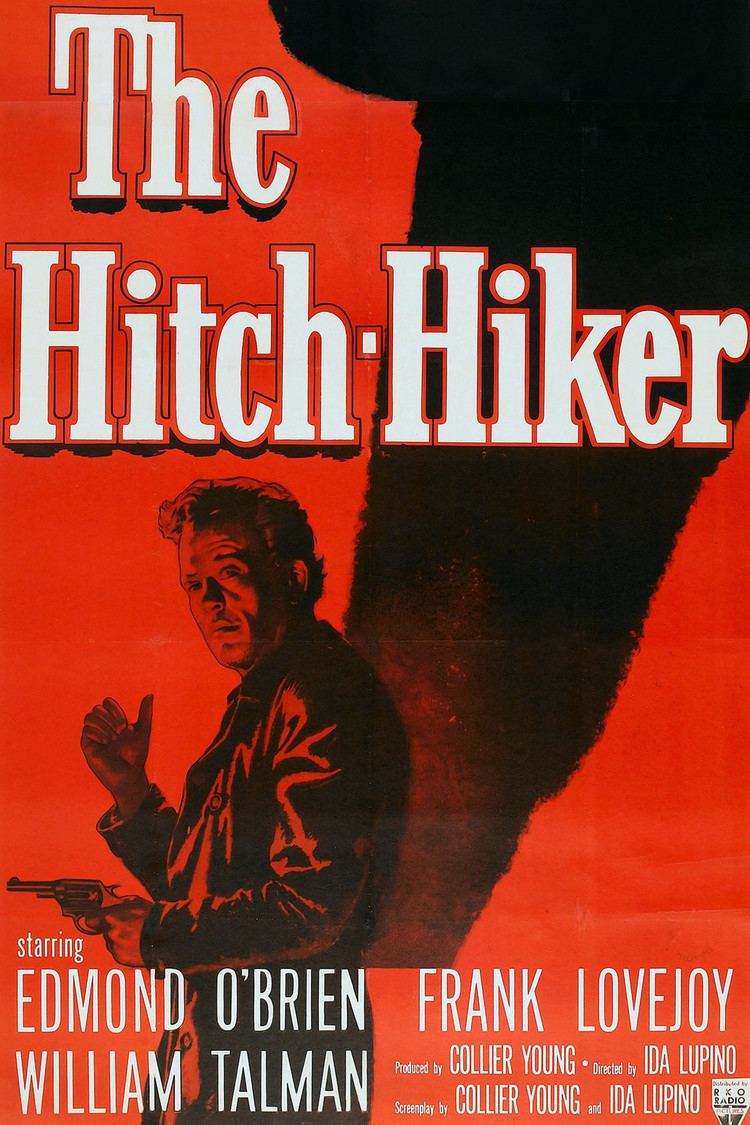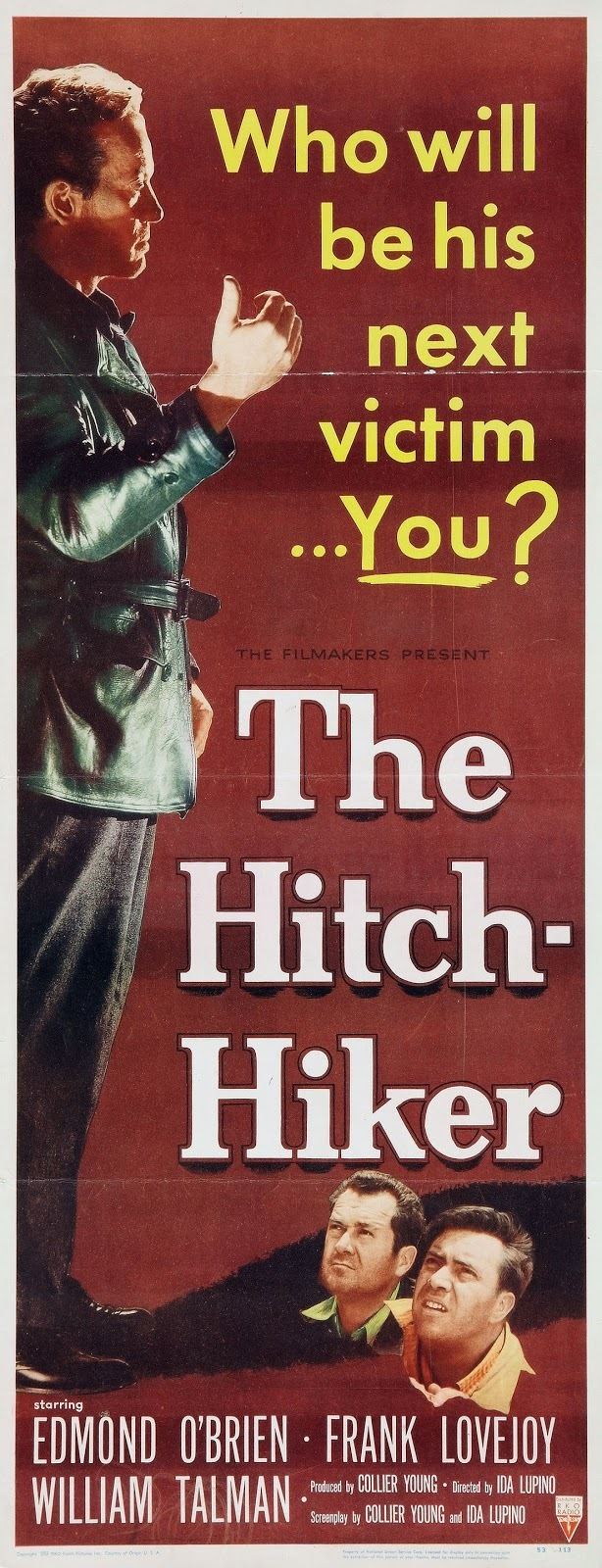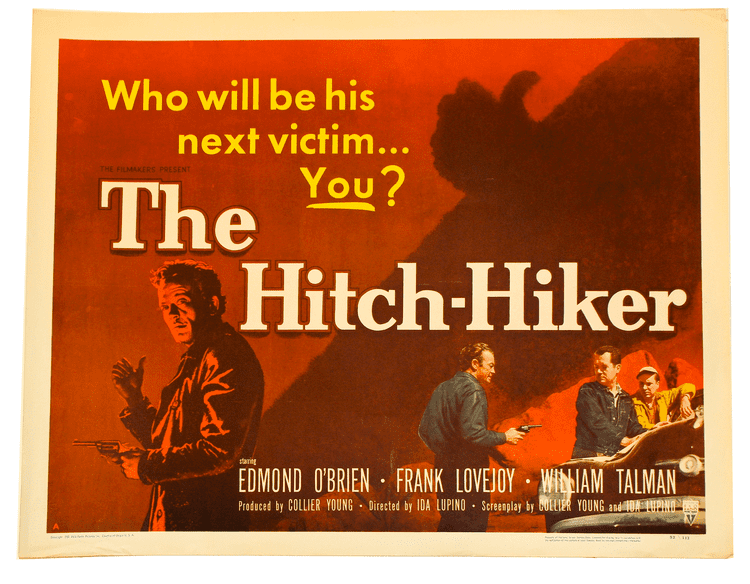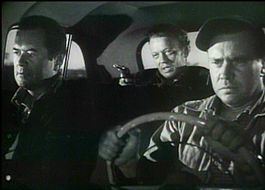8.6 /10 1 Votes8.6
100% Rotten Tomatoes | 7/10 IMDb Initial release 20 March 1953 (Boston) | |||||||||||||||||||||||||||||||||
 | ||||||||||||||||||||||||||||||||||
Screenplay by Ida LupinoCollier Young Starring Edmond O'BrienFrank LovejoyWilliam Talman Cast Edmond O'Brien, Frank Lovejoy, William Talman, José Torvay, Clark Howat Similar The Bigamist, The Maltese Falcon, Laura, The Man Who Shot Liberty V, The Big Sleep | ||||||||||||||||||||||||||||||||||
The Hitch-Hiker is a 1953 film noir directed by Ida Lupino, about two fishing buddies who pick up a mysterious hitchhiker during a trip to Mexico. Inspired by the crime spree of the psychopathic murderer Billy Cook (1928–1952), the screenplay was written by Robert L. Joseph, Lupino, and her husband Collier Young, based on a story by blacklisted Out of the Past screenwriter Daniel Mainwaring (who did not receive screen credit).
Contents

The Hitch-Hiker is regarded as the first American mainstream film noir directed by a woman and was selected in 1998 for preservation in the United States National Film Registry as being "culturally, historically or aesthetically significant."

Plot summary

Two men (Edmond O'Brien and Frank Lovejoy) from El Centro, California are driving toward a planned fishing trip at the Mexican town of San Felipe on the Gulf of California. Just south of Mexicali, they pick up a hitchhiker named Emmett Myers (William Talman), whose stolen car has apparently run out of gas. Myers turns out to be a psychopath who has committed multiple murders while hitch-hiking between Illinois and Southern California, and has managed to slip into Mexico at Mexicali. To evade the pursuing authorities, Myers forces the two men at gunpoint to journey deep into the heart of the Baja California Peninsula, toward the town of Santa Rosalía, where he plans to take a ferry across the Gulf of California.
Meanwhile, the men try to plot their escape from the violent, paranoid Myers. They try tactics such as sabotaging their car and leaving clues (like an engraved wedding ring) at various points on their journey. One man badly twists his ankle during an escape attempt. The sadistic Myers physically and mentally torments the men, forcing them to continue on foot and mocking their loyalty to each other by claiming that they could have escaped separately if they embraced Myers' each-man-for-himself ethos.

Arriving at Santa Rosalía, Myers tries to conceal his identity by forcing one of the men to wear his clothes. Myers, upon discovering that the regular ferry to Guaymas has burned down, hires a fishing boat. However, while he is awaiting the fisherman, locals discover his status as a wanted murderer and contact authorities. Police surround the pier and, after some confusion over Myers' identity, take him into custody following a brief scuffle in which the boastful Myers is revealed to be a coward.
The film ends with the weary friends agreeing to give statements to police.
Cast

Collier Young, the then husband of director Ida Lupino and the co-writer of the screenplay, makes an uncredited appearance in the film as a Mexican peasant.
Background
The inspiration for "The Hitch-Hiker" is the true-life story of Billy Cook, who in California in 1950, murdered a family of five and a traveling salesman, then kidnapped Deputy Sheriff Homer Waldrip from Blythe, California. Cook ordered his captive to drive into the desert, where he tied Deputy Waldrip up with blanket strips and took his police cruiser, leaving Waldrip to die. Waldrip got loose, however, walked to the main road, and got a ride back to Blythe. Cook was tried, convicted, and received the death penalty. On December 12, 1952, Cook was executed in the gas chamber at San Quentin State Prison in California.
Production
The Hitch-Hiker went into production on June 24, 1952 and wrapped in late July. The director of photography was RKO Pictures regular Nicholas Musuraca. Location shooting took place in the Alabama Hills near Lone Pine and Big Pine, California. Working titles for the film were "The Difference" and "The Persuader".
Lupino was a noted actress who began directing when Elmer Clifton got sick and couldn't finish the film he was directing for Filmakers Inc., the production company founded by Lupino and her husband Collier Young to make low-budget, issue-oriented movies. Lupino stepped in to finish the film and went on to direct her own projects. The Hitch-Hiker was her first hard-paced, fast-moving picture after four "women's" films about social issues.
Lupino interviewed the two prospectors whom Billy Cook had held hostage, and got releases from them and from Cook as well, so that she could integrate parts of Cook's life into the script. To appease the censors at the Hays Office, however, she reduced the number of deaths to three. The Hitch-Hiker premiered in Boston on March 20, 1953 and immediately went into general release. The film was marketed with the tagline: "When was the last time you invited death into your car?"
Critical response
A.H. Weiler, the film critic for the New York Times, gave The Hitch-Hiker a mixed review on its initial release. The acting, direction, and use of locations were praised, but the plot was deemed to be predictable.
Critic John Krewson lauded the work of Ida Lupino, and wrote, "As a screenwriter and director, Lupino had an eye for the emotional truth hidden within the taboo or mundane, making a series of B-styled pictures which featured sympathetic, honest portrayals of such controversial subjects as unmarried mothers, bigamy, and rape...in The Hitch-Hiker, arguably Lupino's best film and the only true noir directed by a woman, two utterly average middle-class American men are held at gunpoint and slowly psychologically broken by a serial killer. In addition to her critical but compassionate sensibility, Lupino had a great filmmaker's eye, using the starkly beautiful street scenes in Not Wanted and the gorgeous, ever-present loneliness of empty highways in The Hitch-Hiker to set her characters apart.
Time Out Film Guide wrote of the film, "Absolutely assured in her creation of the bleak, noir atmosphere – whether in the claustrophobic confines of the car, or lost in the arid expanses of the desert – Lupino never relaxes the tension for one moment. Yet her emotional sensitivity is also upfront: charting the changes in the menaced men's relationship as they bicker about how to deal with their captor, stressing that only through friendship can they survive. Taut, tough, and entirely without macho-glorification, it's a gem, with first-class performances from its three protagonists, deftly characterised without resort to cliché."
In January 2014, a restored 35mm print was premiered by the Film Noir Foundation at Noir City 12 at the Castro Theatre in San Francisco. On, April 6, 2014 The Hitch-Hiker was shown again at the Egyptian Theatre in Hollywood. Mary Ann Anderson author of The Making of The Hitch-Hiker appeared at this event.
Noir analysis
While most films noir were filmed in claustrophobic cities, The Hitch-Hiker was filmed in the desert southwestern United States (territory similar to that of Baja California, where most of the story takes place), mostly in wilderness and small villages. Critics Bob Porfiero and Alain Silver, in a review and analysis of the film, praised Lupino's use of shooting locations. They wrote, "The Hitch-Hiker's desert locale, although not so graphically dark as a cityscape at night, isolates the protagonists in a milieu as uninviting and potentially deadly as any in film noir."
